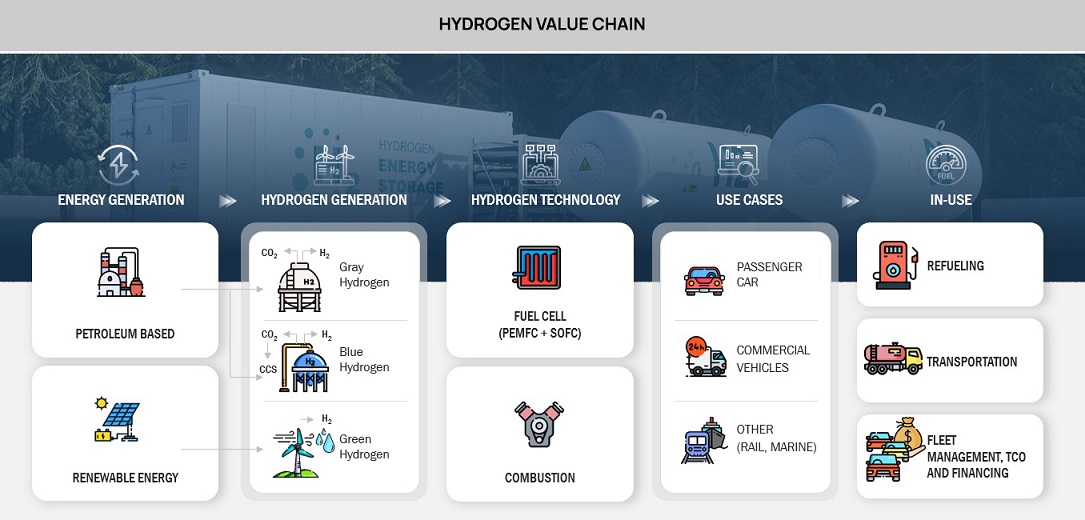HYDROGEN TECHNOLOGIES
The most common element in the universe, hydrogen, has long been hailed as a promising clean fuel for the future. That future might be closer than ever thanks to massive investments made in hydrogen research and development by energy and automakers.
Download PDF: https://www.marketsandmarkets.com/industry-practice/RequestForm.asp.
Hydrogen and oxygen react chemically to produce electricity in hydrogen fuel cells; the only byproduct is water. Because of this, hydrogen produced using renewable energy sources like solar and wind has no emissions. Today’s road-worthy hydrogen fuel cell vehicles are produced by Toyota, Honda, Hyundai, and other automakers. However, a lack of infrastructure for refueling has prevented broader adoption.
Now, if slowly, that infrastructure is beginning to appear. Less than 50 public hydrogen filling stations can be found in the US at the moment, most of them are in California, where laws favor zero-emission cars. Over the next ten years, energy companies such as Shell and BP have announced plans to rapidly expand the number of hydrogen stations in the nation.
Production-wise, electrolysis techniques for removing hydrogen from water are becoming more advanced. Modular electrolyzers that run on renewable energy have been developed by startups. So-called “green hydrogen” is getting close to challenging conventional hydrogen production from natural gas as solar and wind power become more affordable.
Significant infrastructure legislation enacted last year also increase federal funding for the study and development of hydrogen. Within the next ten years, the Department of Energy wants to cut the price of clean hydrogen by 80%.
But problems still exist. Large-scale hydrogen fuel transportation and storage need new storage tanks, pipelines, and other infrastructure. Also, the cost of hydrogen fuel cell cars is still higher than that of gasoline-powered ones.
Whether hydrogen becomes a common fuel is still up in the air. However, as more car manufacturers and energy giants place significant bets on hydrogen, this cleaner fuel might finally have a chance to power the future.
Here is an overview explaining some key hydrogen technologies:
Hydrogen Fuel Cells: Hydrogen and oxygen undergo an electrochemical reaction in fuel cells to produce electricity. Fuel cells are emission-free and highly efficient. Different kinds of fuel cells are employed in portable power systems, automobiles, and buildings. Adoption has been constrained, though, by high costs.
Hydrogen Production: Nowadays, the majority of hydrogen is created by steam methane reforming natural gas. However, “green hydrogen” can also be created by electrolyzing water to separate the hydrogen and oxygen using electricity generated from renewable sources. R&D is focused on renewable hydrogen production techniques.
Hydrogen Storage: Because hydrogen is a light, gaseous element, storing it efficiently is difficult. Hydrogen can be compressed or liquefied for storage or bonded with other materials. New storage methods are needed to increase capacity and reduce costs.
Hydrogen Transportation: Hydrogen is currently transported via pipelines, trucks, trains, and ships, but in order to support a larger hydrogen energy economy, capacity needs to increase significantly. Investments in new pipelines and infrastructure are essential.
Hydrogen Refueling: There are currently only a few hydrogen stations in existence. An expanded infrastructure for gaseous and liquid hydrogen refueling is necessary for the widespread consumer adoption of hydrogen fuel cell vehicles. Fueling is made simple.
In conclusion, major areas of concentration for hydrogen technologies include lowering the cost of production and storage, extending the infrastructure for distribution, and enhancing the longevity and efficiency of fuel cells. By overcoming these technical obstacles, hydrogen’s potential as a flexible and clean energy source can be realized.
Read More: https://www.marketsandmarkets.com/industry-practice/hydrogen/hydrogen-technologies-comparison






